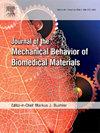软材料中光学诱导液滴空化的超高速动力学实验与数值研究。
IF 3.3
2区 医学
Q2 ENGINEERING, BIOMEDICAL
Journal of the Mechanical Behavior of Biomedical Materials
Pub Date : 2024-10-13
DOI:10.1016/j.jmbbm.2024.106776
引用次数: 0
摘要
全氟化碳(PFC)液滴是一类新型相移造影剂,有望应用于生物医学和生物工程领域。全氟化碳液滴在受到声学或光学触发时会发生快速的液-气转换,为诊断成像中的造影剂和治疗系统中的局部给药载体提供了一种潜在的适应性强、用途广泛的工具。在本文中,我们利用先进的成像技术研究了三种不同浓度的水凝胶中光学诱导 PFC 液滴汽化的超高速惯性动力学和整流准静态(低速)扩散演化,考察了液滴大小和 PFC 核心对气泡动力学和材料粘弹性能的影响。明胶水凝胶显示了浓度对气泡膨胀和材料弹性的影响。在明胶中嵌入 PFC 液滴会增加内部压力,导致更高的平衡半径,并在准静态演化过程中使气泡持续增长。在纤维蛋白和聚丙烯酰胺基质中也观察到类似的趋势,气泡行为的差异归因于基质特性和液滴的存在。有趣的是,液滴大小在惯性动力学过程中对气泡膨胀的影响极小,但对准静态演变的影响却很大,较大的液滴会导致气泡在 60 秒后持续增长。此外,PFC 液滴的核心成分也会对气泡行为产生重大影响,沸点较高的液滴会表现出更高的最大膨胀率和更快的准静态溶解速率。总之,这项研究揭示了液滴特性、基质特性和多时标气泡动力学之间错综复杂的相互作用,为了解它们在仿生物水凝胶中的行为提供了宝贵的见解。本文章由计算机程序翻译,如有差异,请以英文原文为准。
Experimental & numerical investigations of ultra-high-speed dynamics of optically induced droplet cavitation in soft materials
Perfluorocarbon (PFC) droplets represent a novel class of phase-shift contrast agent with promise in applications in biomedical and bioengineering fields. PFC droplets undergo a fast liquid-gas transition upon exposure to acoustic or optical triggering, offering a potential adaptable and versatile tool as contrast agent in diagnostic imaging and localized drug delivery vehicles in therapeutics systems. In this paper, we utilize advanced imaging techniques to investigate ultra-high-speed inertial dynamics and rectified quasi-static (low-speed) diffusion evolution of optically induced PFC droplet vaporization within three different hydrogels, each of different concentrations, examining effects such as droplet size and PFC core on bubble dynamics and material viscoelastic properties. Gelatin hydrogels reveal concentration-dependent impacts on bubble expansion and material elasticity. Embedding PFC droplets in gelatin increases internal pressure, resulting in higher equilibrium radius and continuous bubble growth during quasi-static evolution. Similar trends are observed in fibrin and polyacrylamide matrices, with differences in bubble behavior attributed to matrix properties and droplet presence. Interestingly, droplet size exhibits minimal impact on bubble expansion during inertial dynamics but influences quasi-static evolution, with larger droplets leading to continuous growth beyond 60 s. Furthermore, the core composition of PFC droplets significantly affects bubble behavior, with higher boiling point droplets exhibiting higher maximum expansion and faster quasi-static dissolution rates. Overall, the study sheds light on the intricate interplay between droplet characteristics, matrix properties, and multi-timescale bubble dynamics, offering valuable insights into their behavior within biomimetic hydrogels.
求助全文
通过发布文献求助,成功后即可免费获取论文全文。
去求助
来源期刊

Journal of the Mechanical Behavior of Biomedical Materials
工程技术-材料科学:生物材料
CiteScore
7.20
自引率
7.70%
发文量
505
审稿时长
46 days
期刊介绍:
The Journal of the Mechanical Behavior of Biomedical Materials is concerned with the mechanical deformation, damage and failure under applied forces, of biological material (at the tissue, cellular and molecular levels) and of biomaterials, i.e. those materials which are designed to mimic or replace biological materials.
The primary focus of the journal is the synthesis of materials science, biology, and medical and dental science. Reports of fundamental scientific investigations are welcome, as are articles concerned with the practical application of materials in medical devices. Both experimental and theoretical work is of interest; theoretical papers will normally include comparison of predictions with experimental data, though we recognize that this may not always be appropriate. The journal also publishes technical notes concerned with emerging experimental or theoretical techniques, letters to the editor and, by invitation, review articles and papers describing existing techniques for the benefit of an interdisciplinary readership.
 求助内容:
求助内容: 应助结果提醒方式:
应助结果提醒方式:


